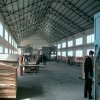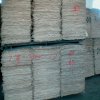No level playing field for plywood
5 May 2005By his own admission, Wei Zhang is no expert in plywood production. A resident of Jiangsu Province for all of his 56 years, the burly Mr Zhang (a pseudo- nym used at Mr Zhang’s request for this article) made a living managing labourers in a metalworks factory in Xuzhou City until 1998, when opportunity knocked in the person of a well-connected second cousin.
“The local government was helping certain entrepreneurs set up factories to process fast-growing wood,says Mr Zhang, “and my cousin was among the lucky ones.”
By 1999, Mr Zhang’s cousin had secured enough government financing to set up a veneer plant in nearby Pizhou, and by 2000, Mr Zhang had traded iron scaffolding for poplar panels. “We had 45 workers when we opened our doors,notes Mr Zhang. “Today we have nearly 300.”
The plant’s focus has widened as well. Stacks of birch and okoume veneer lie wrapped in clear plastic outside the main warehouse alongside neatly matched piles of poplar sheets, which form the bulk of the mill’s sales.
Mr Zhang’s story is not unusual in this booming and densely populated coastal region of eastern China, several hours by car northwest of Shanghai. While numbers are hard to verify, municipal statistics claim over 2,000 operating veneer and plywood plants in Jiangsu Province alone; one of four key plywood producing regions in China (the others are to the north in Shandong Province and, further still, in the northeastern reaches of the country along the Russian and Mongolian borders).
Over 80 of these are plywood plants manufacturing panels. Nearly 50 have production of over 50,000m3 annually, with increasing volumes destined for overseas distributors. While not of that size, Mr Zhang’s operation is growing nonetheless. “We sold almost nothing overseas until 2002,says Mr Zhang. “Today we ship nearly 40% of our panels to Europe, and about 10% to the Middle East.”
Those figures would put Mr Zhang’s plant only slightly below the regional average. According to the municipal website, nearly 60% of the region’s panel and veneer production is exported overseas, the bulk of it in poplar veneer and panels used for furniture construction in Europe and the United States. An increasing volume of birch and okoume, however, is finding its way into the Pizhou panel mix, along with those of many other mills that have sprung up in Eastern China.
According to the official Commission regulation (EC) No 988/2004 of May 17, 2004 (L181/14, May 18, 2004) only 1,093m3 of okoume plywood found its way into the European Union in 1999. By 2001 that number had increased to 9,521m3 and had zoomed to 43,082m3 (or roughly 2,300 20ft containers) by December 2002. A website sponsored in part by China’s Ministry of Forestry and Agriculture, www.chinawood.org, states that exports of all types of plywood have risen 50% in each year since 1999, a figure that would place today’s okoume exports to Europe at considerably higher volumes than those cited in the 2004 Commission Regulation report.
Faced with a strengthening euro, which hit historic highs in 2004 as a result of the US drive to ratchet up debt loads via war and tax relief, European mills are beginning to variously feel the effects of the rising tide of imports. Their responses range from unconcern to frustration.
Major player Finnforest, for example, is focused on a widely diversified product mix at the high end of the panel market and sees no significant threat coming out of China to its traditional birch or softwood panel business in the EU.
“The quality of Chinese panels can be acceptable but it is inconsistent”, says president of panel products Kim Poulsen.
Speaking of the industrial and concrete forming panel market, Mr Poulsen notes: “Out of every five or so loads that are produced, anywhere from one to five can have significant problems.
Beyond that, the pricing levels are ridiculously low. But some of these panels can be used in less demanding applications. Those panels will take a share at the lower end of the market, but not the higher end where Finnforest is established, such as concrete forming systems which require production to exacting stress, bending, shear, and rupture specifications.”
Yet even Finnforest has paid the Chinese manufacturers a compliment. The company, notes Mr Poulsen, is performing value-added work on selected imported Chinese panels for an unidentified European end-user.
Smaller, less diversified firms in Europe are more concerned with Chinese advances than are their larger counterparts. French panel producer Allin le Vanneau, for example, has built its repu- tation on the manufacture of high quality products for the building, yachting and acoustic industries. It produces large amounts of okoume and has experienced a significant impact from Chinese imports of that species in recent years.
“With the low wages they pay their labourers they can market their products with prices at which most Europeans can’t compete. It’s impossible [for smaller European manufacturers] to survive in a situation like that,says company president François Allin.
Yet, like other small and medium-sized firms, Allin is surviving and prospering through innovative product marketing methods that are driven, in part, by the very threats that necessitated the innovations in the first place.
Faced with up to 30% of European okoume usage coming out of China, Allin “took a 90-degree turn in 2003 and put in place a new set of strategies to compete”, says ceo Mr Allin, who has been the president of the European Federation of the plywood industry as well as a panel manufacturer.
Building on the 2003 acquisition of Bruynzeel, a move which strengthened Allin’s position in the high value-added yachting and acoustic component indus- tries, the French manufacturer refocused its marketing to include far more than panel production. Targeting major building markets in the Netherlands and Belgium, Allin representatives present a ‘package’ of expertise that includes product, application information, installation consulting and advice covering critical components such as adhesives, fasteners and coatings. The approach has involved a significant investment by Allin and one which the company’s ceo expects to begin paying off in 2005.
Despite the promise of the high value-added strategy, however, Mr Allin remains worried. “No company can sur- vive on high-end products,he notes. “Everyone has to have a strong mix of basic products as a foundation. But that is where we feel most threatened. No country, no company, can live on the luxury part of the market alone”.
More than anything else, product mix, value-added services and simple marketing savvy seem to hold the key to the future for European produc- ers, both large and small, as they come to grips with the traffic jam of Chinese containers rolling down the high- ways of Holland, Germany, and France.
Finnforest’s Mr Poulsen agrees. “For a number of years,he reports in an English perfected by six years in the United Kingdom, “Finnforest has transitioned from being a supplier of structural components to being a purveyor of structural designs, application consulting, and even building-related software. Our customers are not just buying a panel. They are buying a whole package of skills that gives them the kind of value with which the mere manufacturer of a panel cannot compete.”
Mr Poulsen’s is a strategy that makes sense for the sophisticated, competitive, and highly-differentiated European wood market.
Companies as different as Finnforest and Allin are demonstrating, in their vastly different markets, just how effective such innovations can be. But China is nothing if not a nation of entrepreneurs and innovators, bursting with energy and rich in a hope which neither poverty nor govern- ment edict can permanently diminish.
“My cousin hopes to build another plant,says Pizhou’s Mr Zhang, referring to a possible opportunity for government assistance to export-oriented operations. He does not know when that might be. But for the moment his nearly 300 work- ers are very busy. And in China, everyone seems to have a second cousin.

